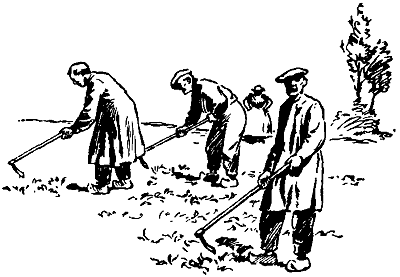Most of us live in towns and don’t much notice what’s growing outside the city limits in the fields. We usually see them from our cars. We drive through them and they’re the pleasant filler between cities. We know something grows there but it’s hard to say exactly what is planted where or when it’s gone again. We also rarely see a farmer. They don’t come to our yoga class or drink coffee in Starbucks. It’s kind of them to knit together the pretty landscape for our sunday drives but we tend to think everything important is happening in skyscrapers or factories.
In more than three months of sunday drives, I’ve been admiring the French farmer. He would be hard to miss. This country is an abundant agricultural showcase. France has just about every configuration of landscape. Every hill and dale has a unique combination of temperature, elevation and rainfall and the farmers have figured out what thrives where. The choice of crop is finely-tuned to the slightest variation. Cherries grow best right here and pears a few yards further over there. Lavender thrives in the afternoon shade of this mountain and hazelnuts like this sunny river bottom. It must take generations of farmers to figure this out.
When we arrived in France, the grains had already been harvested. The fields were just stubble but I’ve seen them ripening on previous trips. In Normandy, they grow all the grains you find in health food store bread. From a distance, I thought we were driving through wheat fields but up close, the plants were unfamiliar. We asked the farmer their names; rye, millet, flax, barley, oats. I didn’t know where those grains were grown and it was a delightful surprise; like discovering where they grow magic beans. Nebraska grows vast fields of corn and soybeans. I don’t want to be disloyal but these seem a wearying monoculture in comparison with France.
The sunflowers were still standing and we watched them ripen. Their yellow petals dry up and fade leaving only the heavy brown seedheads. Over the autumn weeks they droop lower on their stalks and turn from brown to black. The fields get gloomier and gloomier with these dejected hanging heads until the farmer finally puts them out of their misery and harvests.
We were just in time for the grape picking. Some apples were still on the trees but we’d missed most of the fruit harvest. I would’ve like to see how they pick cherries. In the vineyards, crews of 10 or 15 people walk up down the rows of grape vines with large baskets or plastic buckets on their backs. They are generally temporary workers and young people traveling across Europe, earning some money for the next train ticket. It was often raining but good-natured chatter could be heard from across the fields.Sometimes we’d get stuck behind a tractor pulling a wagon full of grapes. These are the less exalted varieties. The farmers take the wagons to a co-op and they’re dumped into a communal depot after being weighed. I’ve often seen wheat farmers doing the same with wagons of wheat but didn’t know it was done with grapes.
We were also in time for the olive harvest. It starts in November and lasts until January. Large green or orange nets are strung out beneath the trees.The pickers hack at the branches with a small rake so the olives fall to the ground and can be gathered up. Most olives are grown for their oil rather than to be stuffed with a pimento. I didn’t realize that.
After all the harvesting, I learn something else surprising. A farmer really proves his worth in the winter Summer’s steamy growth has been cleared away and the soil has been turned. There’s not a weed out of place and the fields are as tidy as a nun’s bed. The farmer’s devotion is revealed by the winter plough.
And with the pruning shears. The patron saint of France should hold a pair in his hands. Rows and rows of lavender are tidily pruned into little mounds. In the orchards, every tree has been pruned to resemble his neighbour. Different fruits need different pruning. Some trees are opened up in the centre to let in the sun. The remaining branches are pulled into place with white or blue tape. Some orchards look like they’ve been decorated with streamers for a party.
There’s also the single plane tree in the farmer’s yard. It’s been growing there for 100 years or more. If you’ve never seen these trees they’re hard to imagine. The trunk is as wide as a wine barrel and shoots straight up to 5 or 6 thick but short branches. They’re splayed out like fingers on a hand and extend to just the right length to cover the yard. Every summer they leaf out to make a parasol of shade. Every winter, all of the leaves and twiggy stems are pruned back again to the bare knobby knuckles of the major branches.
The farmers here are master pruners and there’s a great exhibition of their work currently on show. You can catch it from now until the spring when the new buds will break out and everything starts over again.



Leave a Reply